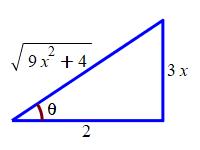7. Trigonometric Substitutions
The trig substitutions of the previous three pages can be generalized to allow for coefficients.
b1. Substitutions for \(a^2x^2+b^2\)
Suppose we see an expression like \(9x^2+4\). This looks like \(x^2+1\) except that there are coefficients. So we still expect to do a \(\tan\) substitution, but slightly modified. We need to define our substitution so that \(9x^2=4\tan^2\theta\) because then \[ 9x^2+4=4\tan^2\theta+4=4(\tan^2\theta+1)=4\sec^2\theta \] Solving \(9x^2=4\tan^2\theta\) for \(x\) gives the substitution \(x=\dfrac{2}{3}\tan\theta\) and \(dx=\dfrac{2}{3}\sec^2\theta\,d\theta\). So it should still be possible to express the integrand in terms of \(\tan\theta\) and \(\sec\theta\) only.
Compute \(\displaystyle \int \dfrac{1}{\sqrt{9x^2+4}}\,dx\).
Let \(9x^2=4\tan^2\theta\) or \(x=\dfrac{2}{3}\tan\theta\). Then \(dx=\dfrac{2}{3}\sec^2\theta\,d\theta\) and so \[\begin{aligned} \int \dfrac{1}{\sqrt{9x^2+4}}\,dx &=\int \dfrac{1}{\sqrt{4\tan^2\theta+4}}\dfrac{2}{3}\sec^2\theta\,d\theta \\ &=\dfrac{1}{3}\int \dfrac{1}{\sqrt{\sec^2\theta}}\sec^2\theta\,d\theta =\dfrac{1}{3}\int \sec\theta\,d\theta \\ &=\dfrac{1}{3}\ln|\sec\theta+\tan\theta|+C \end{aligned}\]
To substitute back, we know \(\tan\theta=\dfrac{3x}{2}\). So: \[\begin{aligned} \sec\theta &=\sqrt{\tan^2\theta+1} =\sqrt{\dfrac{9x^2}{4}+1} \\ &=\dfrac{\sqrt{9x^2+4}}{2} \end{aligned}\] Or we can draw a right triangle with opposite side \(3x\) and adjacent side \(2\) so that \(\tan\theta=\dfrac{3x}{2}\). We conclude: \(\sec\theta=\dfrac{\sqrt{9x^2+4}}{2}\).

Then: \[\begin{aligned} \int \dfrac{1}{\sqrt{9x^2+4}}\,dx &=\dfrac{1}{3}\ln\left|\dfrac{\sqrt{9x^2+4}}{2}+\dfrac{3x}{2}\right|+C \\ &=\dfrac{1}{3}\ln\left|\sqrt{9x^2+4}+3x\right|-\dfrac{1}{3}\ln2+C \end{aligned}\]
We check by differentiating. If \(f(x)=\dfrac{1}{3}\ln\left|\sqrt{9x^2+4}+3x\right|\) then \[\begin{aligned} f'(x) &=\dfrac{1}{3}\dfrac{1}{\sqrt{9x^2+4}+3x} \left(\dfrac{9x}{\sqrt{9x^2+4}}+3\right) \\ &=\dfrac{1}{\sqrt{9x^2+4}+3x}\left(\dfrac{3x+\sqrt{9x^2+4}}{\sqrt{9x^2+4}}\right) =\dfrac{1}{\sqrt{9x^2+4}} \end{aligned}\] which is the integrand we started with.
If the integrand involves the quantity \(a^2x^2+b^2\) then it may be
useful to make a substitution so that \(a^2x^2=b^2\tan^2\theta\). To do
this, let \(x=\dfrac{b}{a}\tan\theta\). Then
\(dx=\dfrac{b}{a}\sec^2\theta\,d\theta\) and:
\[\begin{aligned}
a^2x^2+b^2
&=b^2\tan^2\theta+b^2=b^2(\tan^2\theta+1) \\
&=b^2\sec^2\theta
\end{aligned}\]
So it may be possible to re-express the
integrand in terms of \(\tan\theta\) and \(\sec\theta\) only.
Compute \(\displaystyle \int \dfrac{1}{4x^2+9}\,dx\)
Let \(4x^2=9\tan^2\theta\).
\(\displaystyle \int \dfrac{1}{4x^2+9}\,dx =\dfrac{1}{6}\arctan\dfrac{2x}{3}+C\)
To make \(4x^2=9\tan^2\theta\), we substitute \(x=\dfrac{3}{2}\tan\theta\) and \(dx=\dfrac{3}{2}\sec^2\theta\,d\theta\). Then: \[\begin{aligned} \int \dfrac{1}{4x^2+9}\,dx &=\int \dfrac{1}{9\tan^2\theta+9}\,\dfrac{3}{2}\sec^2\theta\,d\theta \\ &=\dfrac{3}{9\cdot2}\int \dfrac{\sec^2\theta}{\tan^2\theta+1}\,d\theta \\ &=\dfrac{1}{6}\int 1\,d\theta=\dfrac{1}{6}\theta+C \end{aligned}\] To substitute back, we must solve \(x=\dfrac{3}{2}\tan\theta\) for \(\theta=\arctan\dfrac{2x}{3}\). Therefore: \[ \int \dfrac{1}{4x^2+9}\,dx =\dfrac{1}{6}\arctan\dfrac{2x}{3}+C \]
We check by differentiating. If \(f(x)=\dfrac{1}{6}\arctan \dfrac{2x}{3}\) then \[ f'(x) =\dfrac{1}{6}\dfrac{1}{\left(\dfrac{2x}{3}\right)^2+1}\dfrac{2}{3} =\dfrac{1}{4x^2+9} \] which is the integrand we started with.
You can also practice Trig Substitutions by using the following Maplet (requires Maple on the computer where this is executed):
Heading
Placeholder text: Lorem ipsum Lorem ipsum Lorem ipsum Lorem ipsum Lorem ipsum Lorem ipsum Lorem ipsum Lorem ipsum Lorem ipsum Lorem ipsum Lorem ipsum Lorem ipsum Lorem ipsum Lorem ipsum Lorem ipsum Lorem ipsum Lorem ipsum Lorem ipsum Lorem ipsum Lorem ipsum Lorem ipsum Lorem ipsum Lorem ipsum Lorem ipsum Lorem ipsum